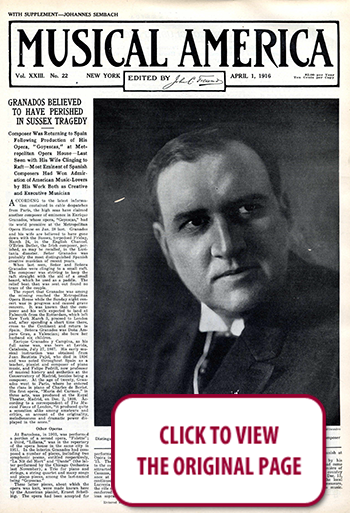 100 YEARS AGO IN MUSICAL AMERICA (137)
100 YEARS AGO IN MUSICAL AMERICA (137)
April 1, 1916
Page 1
GRANADOS BELIEVED TO HAVE PERISHED IN SUSSEX TRAGEDY
Composer Was Returning to Spain Following Production of His Opera, “Goyescas,” at Metropolitan Opera House—Last Seen with His Wife Clinging to Raft—Most Eminent of Spanish Composers Had Won Admiration of American Music-Lovers by His Work Both as Creative and Executive Musician
ACCORDING to the latest information contained in cable dispatches from Paris, the high seas have claimed another composer of eminence in Enrique Granados, whose opera, “Goyescas,” had its world premiere at the Metropolitan Opera House on Jan. 28 last. Granados and his wife are believed to have gone down with the Sussex, torpedoed Friday, March 24, in the English Channel. O’Brien Butler, the Irish composer, perished, as may be recalled, in the Lusitania disaster. Señor Granados was probably the most distinguished Spanish creative musician of recent years.
When last seen, Señor and Señora Granados were clinging to a small raft. The composer was striving to keep the raft straight with the aid of a small board, which he used as a paddle. The relief boat that was sent out found no trace of the couple.
The report that Granados was among the missing reached the Metropolitan Opera House while the Sunday night concert was in progress and caused grave concern. It was known that the composer and his wife expected to land at Falmouth from the Rotterdam, which left New York March 3, proceed to London and, after spending a short time there, cross to the Continent and return to Spain. Señora Granados was Doña Amparo Grau, a Valencian; she bore her husband six children.
Enrique Granados y Campina, as his full name was, was born at Lerida, Catalonia, July 27, 1867. His early musical instruction was obtained from Juan Bautista Pujol, who died in 1896 and was noted throughout Spain as a teacher, pianist and composer of piano music, and Felipe Pedrill, now professor of musical history and aesthetics at the Conservatory of Madrid, besides being a composer. At the age of twenty, Granados went to Paris, where he entered the class in piano of Charles de Beriot. His first opera, “Maria del Carmen,” in three acts, was produced at the Royal Theater, Madrid, on Dec. 2, 1898. According to a correspondent of The Musical Times of London, “it produced quite a sensation alike among amateurs and critics, on account of the originality, melodiousness and dramatic power displayed in the score.”
Other Operas
At Barcelona, in 1903, was performed a portion of a second opera, “Foletto”; a third, “Liliana,” was in the repertory of the opera house in the same city in 1911. In the interim Granados had composed a number of pieces, including two symphonic poems, entitled respectively, “La Nit del Mort” and “Dante” (the latter performed by the Chicago Orchestra last November), a Trio for piano and strings, a string quartet and many songs and piano pieces, among the last-named being “Goyescas.”
These latter pieces, about which the opera was knit, were made known here by the American pianist, Ernest Schelling. The opera had been accepted for performance by the director of the Grand Opera in Paris during the season 1914-‘15. The plan never materialized owing to the outbreak of the war. “Goyescas” attracted the attention of Giulio Gatti-Casazza, who accepted it for performance at the Metropolitan Opera. The continued illness of the Spanish diva, Lucrezia Bori, made it necessary to give the rôle of Rosario to another and it was conferred upon Anna Fitziu, the American soprano. The opera is brief and was coupled with “I Pagliacci” on the occasion of its introduction to New York. The public took kindly to it and, although its success was not of the warmest order, its melodic piquancy and wealth of local color bade fair to establish it firmly in favor here. “Goyescas” had four subsequent performances, three in the subscription season and one at a popular Saturday night, its companion pieces being “Cavalleria Rusticana” and “Hänsel und Gretel.” “Goyescas” is the only Spanish opera ever sung in Spanish at America’s great opera house.
The composer, accompanied by his librettist, Fernando Periquet, had come to New York to attend the première of his work. He arrived in this country as guest of the Metropolitan on Dec. 13, 1915. Prior to his coming, the local concert-going public had, in a measure, been made conversant with his music. Last November Emilio de Gogorza, the famous baritone, sang three of his songs in recital at Æolian Hall.
In the same auditorium, on Jan. 10, 1916, Ernest Schelling played several of the “Goyescas” in their original piano conception, and shortly after that the composer himself, who was a highly accomplished pianist, played some of his music and collaborated with his celebrated countryman, Pablo Casals, the ‘cellist, at the Ritz-Carlton Hotel, before ·the Society of the Friends of Music. On Feb. 22 Granados gave a recital of his own music at Æolian Hall, being aided by Miss Fitziu.
It was expected that Granados would participate in the concert at Carnegie Hall, March 15, for the benefit of students of the Paris Conservatoire. Simultaneously with this invitation, however, came another from the White House in Washington. Granados had already secured passage for himself and his wife on a Spanish steamship and was thus placed in a difficult position. He decided to cancel his engagement and take passage on the Rotterdam, which sailed several weeks ago. The ship reached port safely (it has now been withdrawn from service because of the fear entertained by Holland-America Line officials that she may succumb to a submarine), and it was on the Channel ship that Señor and Señora Granados seem to have perished.




 RENT A PHOTO
RENT A PHOTO





